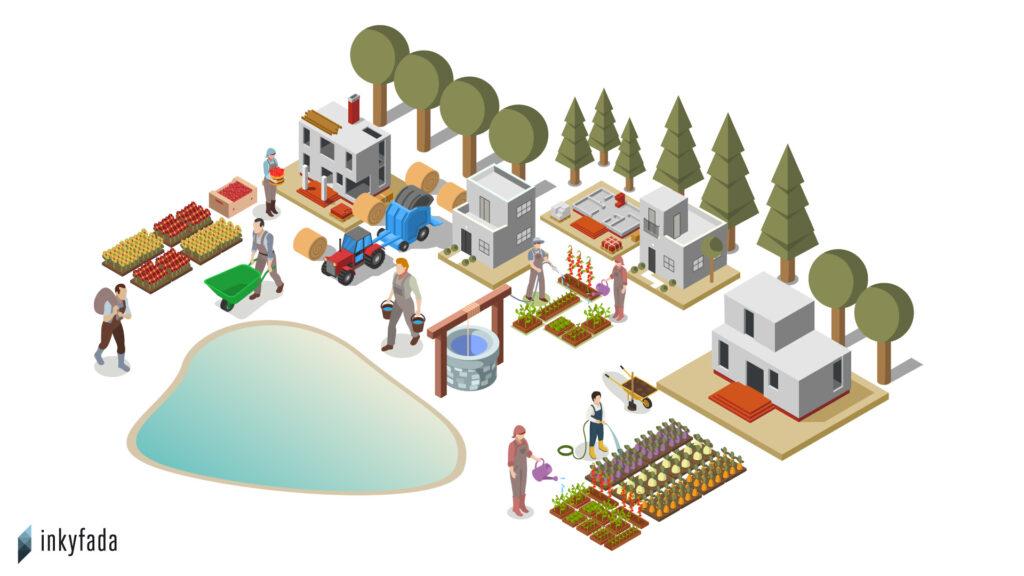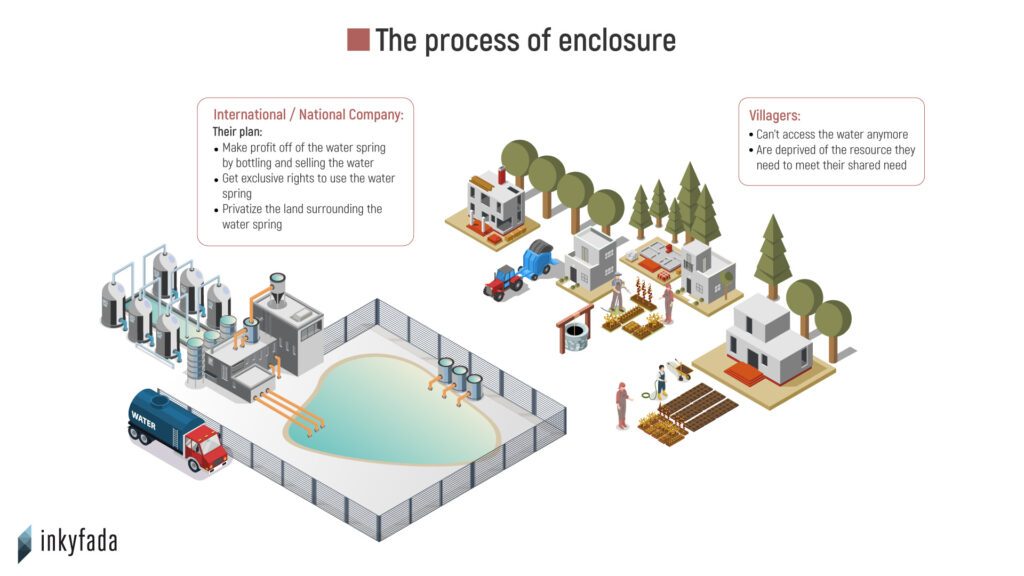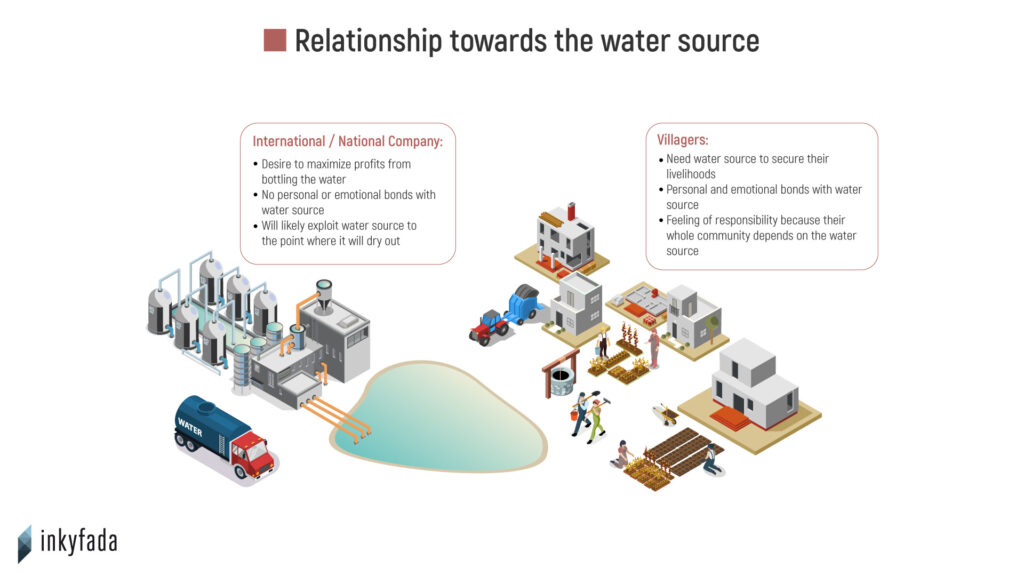The easiest way to understand the concept of commons is with the help of a simple thought experiment:
Imagine a village whose inhabitants discover a water spring with drinking water. The villagers decide to share this resource so that everyone in the village can get their drinking water from it – including future generations. This means that the water spring will neither be owned privately, nor managed by the state.

To ensure this, the villagers organize a meeting where they discuss and collectively decide on rules for the governance of the water spring. While establishing this set of rules, the villagers draw inspiration from the “8 principles of successful commons governance” that were developed by Elinor Ostrom. Ostrom was a political scientist and political economist who dedicated a great deal of her research to patterns of successful commons governance, for which she won the Nobel prize in economics in 2009.
The villagers also develop ways to monitor if people are actually following the rules and decide on sanctions that will be applied if they are not respected. However, rules and sanctions should not be misunderstood as prescriptive formulas, but rather as guidelines embedded within specific social contexts and relations. To make the access to the drinking water easier and safer, the villagers decide to build a well and share stewardship of the water spring – the community’s shared wealth. They agree on collectively building and maintaining the well – be it through contributing to the costs or to the work force required to build and regularly clean the well. The organizational structure is heterarchical, which means it is more decentralized and laterally scaled than vertically integrated and centralized as known from more conventional corporate and governmental models.
Through this dialogue, coordination, and self-organization, the villagers engage in peer governance. Over the course of history, this form of governance has been a way for people living in communities around the world to meet their needs. However, the consequences of imperialism and capitalism – such as the dispossession of people from their land and excessive resource extraction – have led to an increasing dependency on environmental regulation and safeguards to effectively mitigate the negative externalities of the market.
Negative externalities refer to the consequences of economic production that are not reflected in the price of the goods produced or services provided, such as waste, the exploitation of labour, or pollution. In the process of managing the water spring, the villagers are effectively commoning – and thereby creating a commons. While water on its own cannot be considered a commons, the social system that emerges around it can be. Hence, the commons refer not only to goods and services, but also to the social processes that enable them. The commons are relational processes, not fixed entities. They emphasize the social nature of resource governance and economic activity at large, particularly the (monetarily) uncompensated affective labor of care and social reproduction that underlies all forms of economic productivity and societal wellbeing.

Commoning is thus a set of ongoing practices. It is a way of managing a resource like traditions, knowledge or natural resources for the benefit of all through a clearly defined community that agrees on a common set of rules.
As the historian Peter Linebaugh puts it: there is no commons without commoning.
To return to our thought experiment of the village, let’s assume that after a period of successfully managing the water spring as a commons, a big international company discovers the village’s water source and decides it would be a profitable plan to bottle the water and sell it around the world. The company wants to pay for a license from the state that gives them exclusive rights to use the water spring and build a fence around it. This undertaking would likely lead to the privatization of the land from which the villagers’ derive their shared wealth and transform it into a commodity. This process is called enclosure.
Enclosure is a problem all over the world today because it privileges ownership over use rights. “It separates what commoning otherwise connects — people and land, you and me, present and future generations (…)”, as David Bollier and Silke Helfrich write in their book “Free, fair & alive – The insurgent power of the commons”. This becomes evident when observing the historical pattern of states oppressing Indigenous peoples and traditional use rights, and instead installing liberal property rights and the market system in their place. More and more people are being deprived of access to the resources they need to secure their livelihoods as nature is being enclosed, social spaces are increasingly privatized and freedom in the digital world is shrinking in favor of private monopolies.

Back in the village, the international / national company’s idea to privatize the water of the spring is encouraged by the state. The claim is that under this arrangement, the spring would be better taken care of. The state argues as follows: If the international / national company does not take over the responsibility of the water spring, every villager will use as much of the water as possible for their own households but also for watering their fields, since many villagers depend on agriculture to secure their livelihoods. This will eventually lead to the drying up of the spring. The state justifies this claim by quoting the so-called “tragedy of the commons”, a theory which became widely known after the ecologist Garrett Hardin published an essay with the same title in 1968, where he paints a picture of a shared pasture open to a number of herders. According to him, not a single herder would consider limiting the number of his grazing cattle, inevitably leading to the overuse of the pasture. He refers to this phenomenon as the ”tragedy of the common”.
The risk of a profit-oriented company taking control over the village’s water source, is that it might be enticed to extract more water than the source can naturally replenish, polluting the area around the source along the way. The main issue with the tragedy of the commons theory is that it does not actually describe a commons but rather an open access regime without shared rules and responsibilities. Hardin’s argument thus reaffirms the alleged inevitability of private property by misrepresenting the commons as an alternative. When speaking of a commons, it is helpful to think of property as something that is relational. This notion helps us to imagine “other ways of having” in the place of “owning” which recognize the social relationships that are intertwined with any landscape, building, sacred space, or creative work.
In reality, the villagers do not only steward and govern the spring, but also derive water from it to meet a shared need. They have formed mutually reciprocal relationships which entail responsibility for a shared resource that they all depend on. It is thus in their best interest to guarantee the spring’s protection and maintenance, not only for their generation, but for future generations to come.
The international / national company’s modus operandi couldn’t be more opposite to this reality. Driven by a desire to maximize profits and lacking any personal or relational bonds to the land, the company assigns a market value to the water and thus severs the social relationship between the community and the land. The social practices, norms, local knowledge, skills and social meaning related to the land gradually erode as a result.

Commons can take countless forms, there is no one size fits all.
Certain patterns of governance appear to yield higher chances of success. However each social practice must be adapted to the specific context it is applied to. The best way to get a feel for what commons are, is to experience them firsthand or by learning about real-life examples. Commons can emerge when people take care of a community garden, when local seeds are protected or when people share their knowledge, in virtual and physical spaces. All commons share the aim to decentralize governance, emphasize sustainability and democratically include all stakeholders in decision-making processes.
Luckily, there are numerous resources online and books such as “Think like a commoner” (David Bollier), “Free, fair & alive – The insurgent power of the commons” (David Bollier and Silke Helfrich), “Patterns of Commoning” (David Bollier and Silke Helfrich) and “The Commoners Catalog for Changemaking” (David Bollier) which describe a multitude of commons.
In Tunisia, one can find many commoning practices as well as elements of commoning amongst rural and urban communities. Here are some examples:
Dar Emmima & L’ombre du palmier: education centers that offer workshops on the principles and values of permaculture and support people in establishing sustainable agricultural ecosystems.
Association des Amis de Belvedere: a group of people concerned with preserving the ecological and cultural heritage of Parc du Belvedere, the largest green and public space in central Tunis, as well as offering creative and educational activities, particularly to children.
Potager d’Ommi Faiza: a self-organized community garden run by a group of retirees in Cité CNRPS in Menzah 6. It’s a place where community members meet with students and residents and share knowledge about ecology, gardening, and active citizenship. The community is also currently supporting ENAU students in establishing a vegetable garden on the university premises.
Cartographie Citoyenne: an organization which provides open access of data through interactive maps. The organization also creates maps together with different communities to deepen understanding of local issues such as pollution, safety in the public space and mobility. Enabling citizens access to accurate and accessible data, is in their opinion a basis for participatory democracy.
…& many more.



